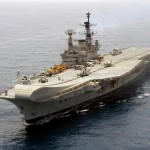For global shipping, COVID-19 is a Black Swan event – an unexpected and rare event which had disrupted maritime supply chains. Global shipping carries 90% of world trade and is the lifeblood of the global economy but was paralyzed due to Covid in the early months of this year. Mariners on active duty aboard tankers and merchant ships were stranded on the high seas and unable to disembark at their destination ports. Just as airports were shut across the world, so were most ports. It’s only fitting that on World Maritime Day day we acknowledge the resilience of merchant sailors for enduring months at sea while not knowing when they would see their families.
Closer to home in Mumbai, the former Flag Ship of India’s Western Fleet headquartered in Mumbai – the Aircraft Carrier INS Viraat or R 22 – was towed away on 19 September to the ship-breaking yard in Alang, Gujarat. This brought down the curtains on Viraat’s glorious career of 58 years at sea. The Indian Navy Ship Viraat is the longest serving aircraft carrier in the world having seen active service from 1959 to 2017.
India acquired the Viraat from the United Kingdom only in 1986, and this was 4 years after she was the Flagship of the Royal Navy in the 1982 Falklands War with Argentina. Named Her Majesty’s Ship Hermes, construction of this 22,000-ton[1] Centaur Class Light Fleet Aircraft Carrier — the last in the series – began after the Second World War. She was inducted into the Royal Navy in 1959.
When Britain offered the Hermes to India for outright purchase, the Indian government grabbed the offer. Ever since the release of the First White Paper of 1947 for the development of independent India’s Navy, which outlined a need for a two carrier Navy, there had been a pending need for two aircraft carriers – one for India’s Western Fleet and the other for its Eastern.
The importance of an Aircraft Carrier in any naval fleet is that it gives “wings” to a Fleet, as it carries fighter jets onboard. When India inducted its first Aircraft Carrier – INS Vikrant in 1961, it marked the beginning of naval aviation not just in India but in Asia. The Viraat was unique because it had a ski-jump shaped flight deck and a squadron of Sea Harrier fighter jets known for their Vertical and/or Short Take-off and Landing (V/STOL). This meant these jets could land or take-off (the latter without a payload) vertically like helicopters or use the Viraat’s flight deck with a ramp. Landing a fighter jet on a moving platform when a carrier is at sea, makes naval aviation particularly challenging but the pay-offs in having an aircraft carrier-led blue water fleet have been substantial.
Two highlights of the Viraat’s career were Operation Jupiter in 1989 when she embarked the Seventh Battalion of the Garhwal Rifles who were inducted into the war zone in Sri Lanka as part of the Indian Peace Keeping Force there. The Viraat kept a measured distance from the war zone but during Operation Jupiter, her crew trained a largely foot-slogging Garhwali battalion into an airborne assault group. This operational experience between the Garhwalis and the Viraatis was later cemented into a formal affiliation between the two.
The attack on India’s Parliament on 13 December 2001 by terrorists aided and abetted by Pakistan, launched the Indian Navy’s Operation Parakram from 2001 to October 2002. The Viraat carrier fleet was continuously deployed to exercise sea control in the North Arabian Sea just outside Pakistani waters. Operation Parakram demonstrated the primacy of the Indian Navy in executing an aggressive foreign policy intent through its calibrated presence and the tactical maneuvering of its Fleet. This Op lasted till October 2002 when tensions were diffused through diplomatic channels.
So today, although the Viraat is no longer with us – it is good to remember that ships always reincarnate themselves or are like Phoenixes rising from the ashes. Newly inducted ships in the Fleet are often named after their famous predecessors. The Indian Navy is awaiting the commissioning of a new aircraft carrier Vikrant, named after the Indian Navy’s first carrier. Just as it will one day induct another new carrier and name it after the Viraat.
Epilogue: News reports of 30 September state that there is a good chance of the INS Viraat being converted into a floating museum in Goa. This offer to purchase the Viraat before it is broken down is from a private company and is pending the approval of the Ministry of Defence.
Sifra Lentin is Bombay History Fellow, Gateway House.
This blog was exclusively written for Gateway House: Indian Council on Global Relations. You can read more exclusive content here.
For interview requests with the author, or for permission to republish, please contact outreach@gatewayhouse.in
© Copyright 2020 Gateway House: Indian Council on Global Relations. All rights reserved. Any unauthorized copying or reproduction is strictly prohibited.
References
[1] The INS Viraat’s total tonnage after an extensive refit before being inducted into the Indian Navy was 28,700 tons. Source: Jane’s Intelligence Yearbook 1994, page 127.


